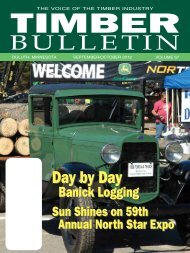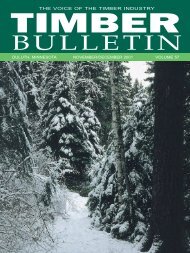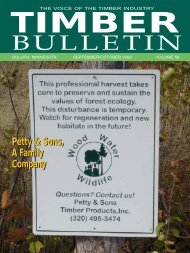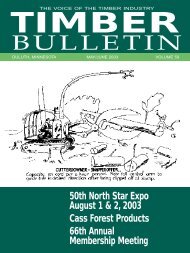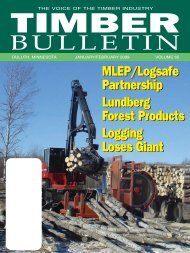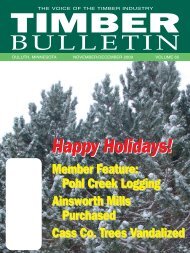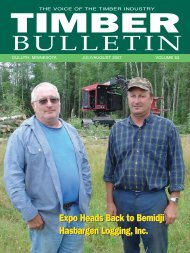Timber Bulletin Nov/Dec - Minnesota Forest Industries
Timber Bulletin Nov/Dec - Minnesota Forest Industries
Timber Bulletin Nov/Dec - Minnesota Forest Industries
Create successful ePaper yourself
Turn your PDF publications into a flip-book with our unique Google optimized e-Paper software.
The Classroom Outside<br />
Report on Fall 2002 <strong>Forest</strong> Management Guidelines Training –<br />
Protecting Site Quality: <strong>Forest</strong> Management and <strong>Timber</strong> Harvesting<br />
A joint training effort from UMN<br />
College of Natural Resources Center<br />
for Continuing Education and<br />
<strong>Minnesota</strong> Logger Education Program<br />
Sometimes the best learning is<br />
done outside of the classroom. This<br />
fall, more than 800 loggers and<br />
resource managers spent a day in<br />
the forest at one of 11 workshops<br />
held around the state. These<br />
workshops provided field<br />
demonstrations of key ways to<br />
protect soil and water at logging<br />
sites. These demonstrations were<br />
designed to support improved<br />
understanding of <strong>Minnesota</strong>'s<br />
voluntary timber harvesting and<br />
forest management guidelines.<br />
Some highlights from the day:<br />
• Overall there is a high level of<br />
compliance with the guidelines.<br />
Here are a few examples from the<br />
logging sites monitored in 2001:<br />
– All landings were located on<br />
stable ground;<br />
– Infrastructure, i.e. roads and<br />
landings, within a logging site<br />
averaged 3.2 percent as<br />
compared to 3 percent set in<br />
the guidelines; and<br />
– Over 80 percent of the general<br />
harvest areas met<br />
recommendations for downed<br />
logs.<br />
• Three areas of the guidelines had<br />
lower compliance, which led to<br />
this series of workshops:<br />
– Installation of enough water<br />
diversion structures;<br />
– Details of the approaches to<br />
and crossings of open water<br />
and wetlands; and<br />
– Limitation of soil compaction.<br />
• Loggers and resource managers<br />
received and practiced using a<br />
new tool – the slope<br />
measurement gauge.<br />
Remember that all monitored<br />
sites were harvested and/or the<br />
stumpage sold before publication<br />
of the guidelines book and<br />
introductory training workshops.<br />
This means the monitoring results<br />
are considered baseline information<br />
to compare with sites harvested<br />
after loggers and resource<br />
managers had taken guidelines<br />
training. Post-guideline monitoring<br />
results are likely to show higher<br />
levels of compliance.<br />
As usual, loggers and resource<br />
managers provided good feedback,<br />
and asked good questions. During<br />
each of the 11 workshops,<br />
instructors gathered participants’<br />
verbal comments and questions, as<br />
well as comments on worksheets<br />
completed during the afternoon<br />
exercise. Here is a summary of<br />
those points:<br />
1. There is a generally good level<br />
of understanding among<br />
loggers and resource managers<br />
about basic implementation of<br />
the guidelines.<br />
2. Workshop participants would<br />
(continued on page 14)<br />
12<br />
<strong>Timber</strong> <strong>Bulletin</strong> <strong>Nov</strong>ember/<strong>Dec</strong>ember 2002



